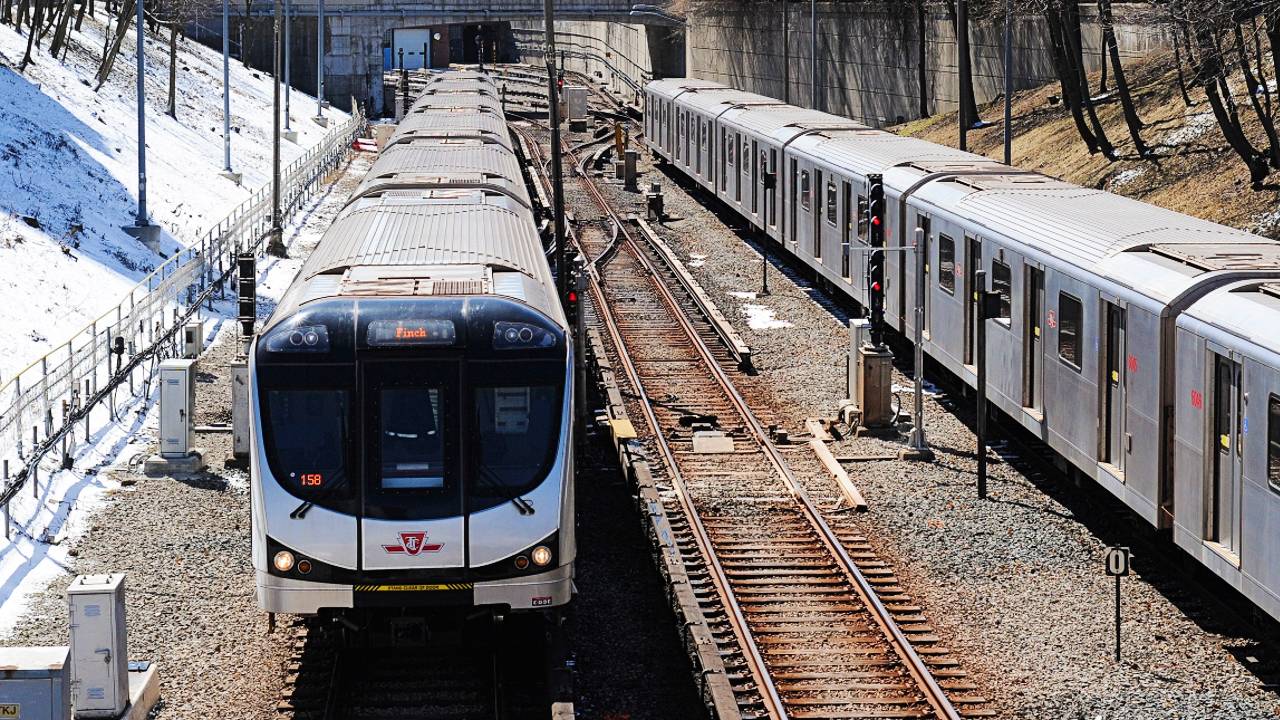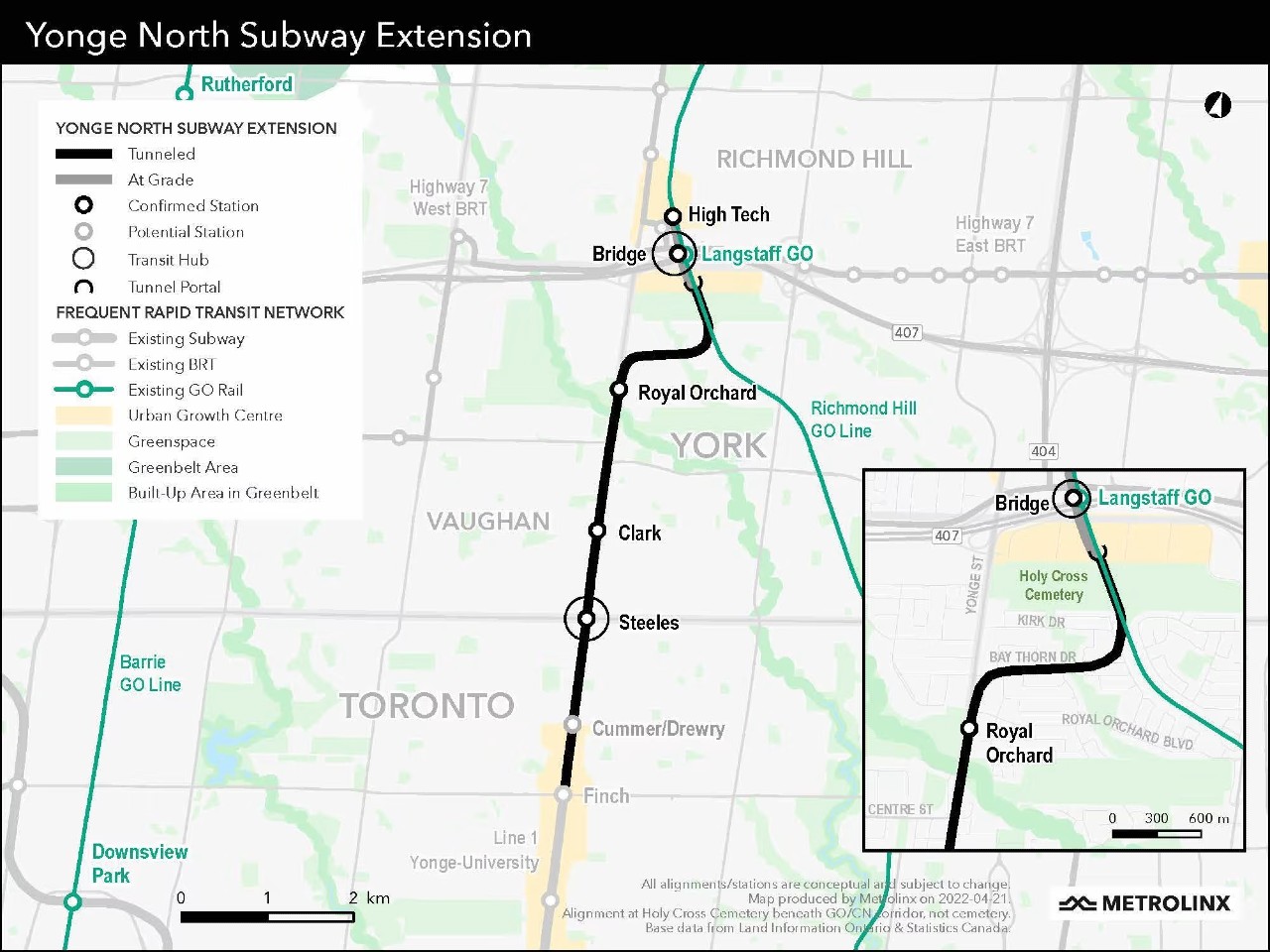North to Richmond Hill: Breaking down the 8-km Yonge subway extension
Toronto’s next big mass transit project just took a significant step forward. Here’s the latest.

The new TTC Line 1 subway extension is taking another big step forward. On April 25, the Ontario government released a Request for Qualifications (RFQ) for tunnelling work, bringing it ever closer to reality.
That said, many out there may be surprised to hear it’s happening at all. With the bulk of the Toronto transit talk lately surrounding the Eglinton Crosstown, the Ontario Line, and the Scarborough Subway Extension, the Line 1 extension has flown a little under the radar.
So what is this project, why are we building it, and when can we get on board?
Read on for an explainer, and check our map visualization for an idea of what it might look like when fully built.

Where will the extension go?
The Yonge North Subway Extension is a planned eight-kilometre extension of Toronto's Line 1. It will run from the longtime Yonge-side terminus at Finch Station to just beyond Highway 7 at Richmond Hill Centre in York Region.
The project is designed so that trains will head north out of Finch via newly excavated tunnel tubes.
After passing Royal Orchard Blvd., the tunnels will swing east underground, and then back to the north to pop above ground next to the GO Richmond Hill Line. The subway will then continue a short distance before terminating at a station called “High Tech,” named after the adjacent street at Richmond Hill Centre.
Between Finch and High Tech will be four new stations — at Steeles Ave., Clark Ave., Royal Orchard, and “Bridge” — with a possible fifth additional stop at Cummer Ave.
The stations at Steeles, Clark, and Royal Orchard should be fairly standard subway stations. However, as the line will pop above ground at the north end, both Bridge and High Tech will be surface stations.
It should be noted that the smart approach for the potential Cummer Station would be to provision for building it in the future, even if it’s not part of this project. North York Centre Station was added after the initial Line 1 extension to Finch had already been completed in response to development around it, and something similar could happen at Cummer — which is already getting the large M2M Squared development.
To the north of High Tech will be a small subway yard, which previous plans had underground. This yard will be used for storing some trains for use at the beginning of service, as well as light maintenance work.
That said, the most visible urban change that will arise from the project (especially since the trains themselves will mostly be underground) are the two massive planned transit-oriented communities (TOCs) that will be placed around Richmond Hill Centre, to the north and south of Highway 7 and Highway 407.
These developments would include at least 30 towers, putting thousands of new residents within a short walk of the new subway, although they’ve been controversial due to their truly extreme density.

What’s next for the project?
Last week, various levels of government and transit authorities came together to announce the RFQ for early tunnel works on the project, which is exciting but perhaps a bit less so than some might expect.
At the RFQ stage, companies apply to be able to bid on a selected stage of the project — in this case, the advanced tunnel works. It isn’t until the next step, known as RFP or “Request for Proposals,” that companies actually bid.
Nonetheless, progress through this process absolutely does matter — and it seems likely that a final contract for tunnels could be signed in the next year or two.
As for the rest of the construction needs for the project, those will be handled at a later date. Metrolinx, in what appears to be a move mostly driven by the delays and high costs of projects such as the Eglinton Crosstown, has been breaking its new subway projects into multiple contracts rather than a single “mega” contract.
The idea here is that more companies can throw their hats into the ring, creating more competition and a lower price for taxpayers.
Of course, working this way means large subway projects will now need to be brought together from several smaller components. It's also not entirely clear that this strategy will help Toronto shake its title as one of the most expensive places in the world to build rapid transit.
In the case of the Yonge subway extension, once the first stage of tunnelling work is awarded and set in motion, separate companies will then be awarded contracts to fit those tunnels out with rails and other equipment as well as build stations.
What are we looking at for costs and dates?
The Yonge subway extension is meant to be complete in the early 2030s, a few years after the Scarborough and Eglinton subway extensions, which makes sense given the delay in beginning tunnelling works for those, and the desire for the much more complicated Ontario Line to be completed first.
Initial costing for the project is between $4.5 and $5.8 billion, but given inflation, supply chain challenges, and the complexity of a major transit project — as well as the risk of delays — that price could easily rise higher.
Projections call for an eventual daily ridership of over 100,000, which sounds high but perhaps shouldn’t be so surprising given the legions of buses that run up and down Yonge St. north of Finch Station. Taking this significant bus traffic off the streets and removing the dogleg at the end of many east-west TTC routes in the area will be a big benefit of the project.
That being said, if the projected ridership numbers are accurate, it will be critical that the Ontario Line is completed and operational before this project. Extending the Yonge subway northwards will only add to its legendary congestion — which the Ontario Line is designed to tackle.
Final thoughts
Here are a few other quick notes about the project:
- Bridge Station is so named because it will pass under both Highway 7 and Highway 407, and bridge the areas on the north and the south. This location is actually quite convenient from a transit-connection perspective, as Viva BRT buses travelling east and west on Highway 7, and GO regional buses travelling east and west on Highway 407, will all be able to connect with the subway here.
- There will also be a connection to Langstaff GO on the existing Richmond Hill line, which will hopefully be renamed in line with the new subway station.
- Interestingly, High Tech Station will only be a few hundred metres north of Bridge, creating possibly the smallest gap between subway stations on the network (the current shortest is between Osgoode and St. Andrew).
Code and markup by Kyle Duncan. ©Torontoverse, 2023